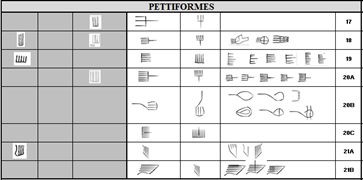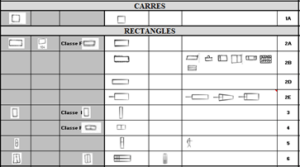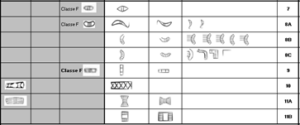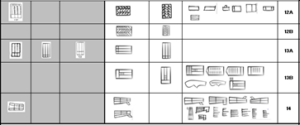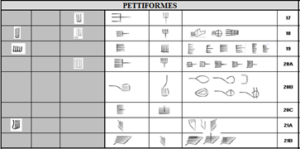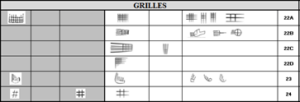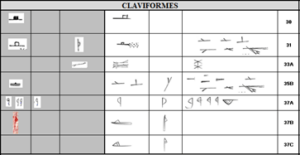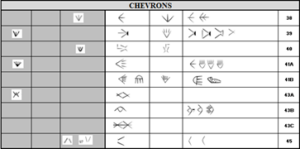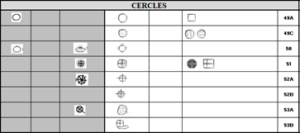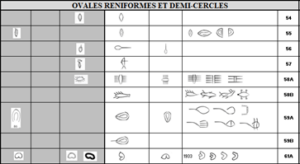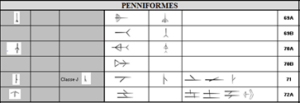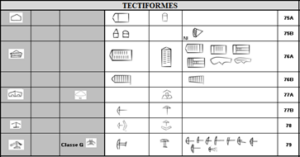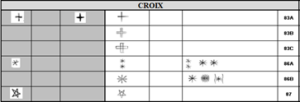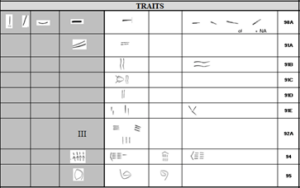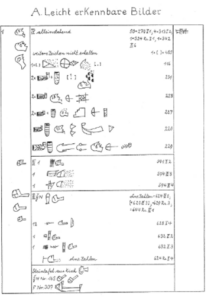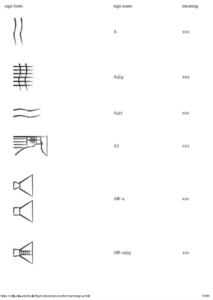PURPOSE OF THIS ARTICLE
This article helps to demonstrate the perfect correspondence between Upper Palaeolithic rock paintings and the proto-Sumerian or proto-Cuneiform ideographic language.
This demonstration is divided into four parts:
The first part (which will be the subject of this article) presents a comparative table between, on the one hand, around a hundred prehistoric signs identified and divided into their 25 categories and, on the other hand, identical signs specific to the proto-Sumerian period. This visual comparison shows that they are extremely similar, and in itself confirms that they are indeed the same writing system.
The second part presents the results of previous research into prehistoric signs.
The third part shows the errors and mistakes made by previous researchers on this issue, which prevented them from reaching the right conclusion.
The fourth part then provides a complete semiological demonstration of the correspondence between the two writing systems, carrying out correctly and exhaustively the comparative background analysis that should have been carried out (comparison of the corpus of signs and semiological rules relating to each system) to arrive at the right result and the right conclusion: the Upper Palaeolithic rock paintings, with their pairs of images and signs, correspond in every respect to the Sumerian ideographic language and its associated languages (Sumerian, hieroglyphic Egyptian).
Table of contents
LINK THIS ARTICLE TO THE ENTIRE LITERARY SERIES “THE TRUE HISTORY OF MANKIND’S RELIGIONS”
This article is an excerpt from the book also available on this site:
Volume 2 Book 2 Deciphering the language of the caves
You can also find this book here :
Already published books
To find out why this book is part of the literary series The True Stories of Mankind’s Religions, go to page :
Introduction / Structure and Content
I hope you enjoy reading this article, which is available in its entirety below:
Part I : Comparison table between rupestral signs and proto-sumerian signs
I have already mentioned the names of illustrious archaeologists whose work has made possible the visual comparison work we are about to undertake.
Indeed, it was Abbé Breuil, the “Pope of prehistory”, who methodically recorded the majority of prehistoric signs, and it was André Leroi-Gourhan who first categorized them according to their basic form, a categorization that Georges and Suzanne Sauvet, and André Wlodarczyk have taken up and consolidated for the needs of their analysis.
We’ll be analyzing their work in detail later.
I quote them because, to facilitate comparison with the results of their research, I thought it would be useful to use in the comparative table that follows exactly the same typology of signs as theirs, the same denomination of the categories of signs they identified in the caves, a typology that is based on the shape of the signs.
I’ve simply added or treated separately in this table four other categories of prehistoric signs also recognized and identified, but not directly treated in their research: long strokes, cupules, splines and spirals.
Like them, I’m not going to mention positive and negative hand signs in this table either, because on the one hand, hands are often dissociated from signs and animals and must therefore be analyzed as distinct symbolic signs, and on the other hand, of all signs, the hand undoubtedly has the greatest symbolic polysemy, so it requires a specific and more thorough contextual analysis, which will be done separately and inserted in volume 3.
Here, on the next 6 pages, is the comparative table[1] :
Sign references for comparative ideographic writing:
If you have any doubts as to whether the ideographic signs I’ve listed for comparison are the product of my imagination, here are the references to their sources, with page numbers for each sign: 1A (CNIL, p. 121) / 2A (CNIL, p. 73) / 2B (Falkenstein, 1936, p. 135) / 2D (CNIL, pp. 81, 82) / 2E (CNIL, p. 230) / 3 (CNIL, pp. 81, 82) / 4 (CNIL, p. 148) / 5 (CNIL, p. 112) / 6 (CNIL, p. 48) / 7 (CNIL, p. 28) / 8A (CNIL, p. 252) / 8B (CNIL, pp. 113, 286, 287) / 8C (CNIL, p. 117) / 9 (CNIL, p. 85) / 10 (CNIL, p. 18) / 11A (CNIL, p. 234) / 11B (CNIL, p. 135) / 12A (Falkenstein, 1936, p. 135) / 12B (CNIL, p. 235) / 13A (CNIL, pp. 48, 285) ; (Falkenstein, 1936, p. 139) / 13B (CNIL, pp. 225, 226, 227, 286) / 14 (CNIL, p. 168) / 15A (CNIL, p. 18) / 15B (CNIL, p. 111) / 16A (CNIL, p. 273) ; (Falkenstein, 1936, p. 96) / 16B (Falkenstein, 1936, p. 96) / 16C (CNIL, p. 95) / 17 (CNIL, p. 68) / 18 (Falkenstein, 1936, p. 93) (CNIL, p. 201) / 19 (Falkenstein, 1936, pp. 133, 135) / 20A (Falkenstein, 1936, p. 91) (CNIL, p. 67) / 20B (CNIL, pp. 128, 129, 133) ; (Falkenstein, 1936, p. 66) / 20C (CNIL, p. 267) / 21A (CNIL, p. 204) / 21B (CNIL, pp. 197, 201) / 22A (CNIL, pp. 210-212) / 22B (Falkenstein, 1936, p. 93) / 22C (Falkenstein, 1936, p. 184) / 22D (CNIL, p. 164) / 23 (CNIL, p. 94) ; / (Falkenstein, 1936, p. 98) / 24 (CNIL, p. 239) / 25A (CNIL, p. 192) / 25B (CNIL, p. 272) / 26A (CNIL, p. 270) / 26B (CNIL, p. 201) / 26C (CNIL, pp. 199, 200) / 27 (Falkenstein, 1936, p. 135) / 29 (CNIL, p. 100) / 30 (CNIL, p. 270) / 31 (CNIL, pp. 222-227) ; (Falkenstein, 1936, pp. 62-66) / 33A (CNIL, p. 204) ; (Falkenstein, 1936, p. 108) / 35B (CNIL, pp. 160,161) ; (Falkenstein, 1936, pp. 62-66) / 37A (CNIL, p. 253) / 37B (CNIL, p. 195) / 37C (CNIL, p. 243) / 38 (CNIL, p. 242) / 39 (CNIL, pp. 174, 179, 180, 181) / 40 (CNIL, p. 275) / 41A (CNIL, p. 246) / (Falkenstein, 1936, p. 110) / 41B (Falkenstein, 1936, p. 160) / 43A (CNIL, p. 21) / 43B (CNIL, pp. 210-212) / 43C (CNIL, p. 281) / 45 (CNIL, p. 200) / 46 (CNIL, pp. 245, 249) / 47 (CNIL, pp. 245, 249) / 48A (CNIL, p. 35) / 48B (CNIL, p. 167) / 48C (CNIL, p. 149) / 49A (CNIL, p. 85) / 49C (CNIL, p. 88) / 50 (CNIL, p. 239) / 51 (CNIL, p. 220) / 52A (CNIL, p. 220) / 52B (CNIL, p. 219) ; 53A (CNIL, p. 273) / 53B (CNIL, p. 89) / 54 (CNIL, p. 107) / 55 (CNIL, p. 187) / 56 (CNIL, p. 249) / 57 (CNIL, p. 78) / 58A (CNIL, pp. 99, 100) / 58B (CNIL, p. 116) / 59A (CNIL, pp. 128, 129, 133) ; (Falkenstein, 1936, p. 66) / 59B (CNIL, p. 133) / 61A (Falkenstein, 1936, p. 89) / 61B (CNIL, pp. 199, 200) / 61C (CNIL, p. 254) / 63 (CNIL, p. 22) / 64 (CNIL, p. 30) / 65 (CNIL, p. 187) / 69A (CNIL, p. 241) / 69B (CNIL, p. 13) / 70A (CNIL, p. 205) / 70B (CNIL, p. 86) / 71 (CNIL, pp. 160, 161) / 72A (CNIL, p. 160) / 73A (CNIL, p. 192) / 73B (CNIL, p. 168) / 73C (CNIL, p. 236) / 75A (Falkenstein, 1936, p. 167) / 75B (CNIL, p. 106) ; (Falkenstein, 1936, p. 166) / 76A (CNIL, p. 227) ; 76B (CNIL, p. 105) / 77A (CNIL, p. 81) / 77B (CNIL, p. 13) / 78 (CNIL, p. 160) / 79 (CNIL, pp. 160-164) / 81 (CNIL, p. 15) / 82 (CNIL, p. 18) / 83A (CNIL, p. 132)/ 83B (CNIL, p. 107) / 83C (CNIL, p. 107) / 86A (CNIL, p. 141) / 86B (CNIL, p. 9) / 87 (CNIL, p. 219) / 88 (CNIL, p. 128) / 89 (CNIL, p. 242) / 90A (CNIL, p. 94) ; (Falkenstein, 1936, p. 341) / 91A (CNIL, p. 79) ; (Falkenstein, 1936, p. 279) / 91B (CNIL, p. 1) / 91C (CNIL, p. 86) / 91D (CNIL, p. 123) ; (Falkenstein, 1936, p. 490) / 91E (CNIL, p. 124) & (Falkenstein, 1936, p. 491) / 92A (Falkenstein, 1936, pp. 88, 97, 124, ) / 94 (CNIL, p. 46) / 95 (CNIL, p. 278) / 96 (CNIL, pp. 125, 126) / 97 (CNIL, p. 122) / 98 (CNIL, p. 120) / 99 (CNIL, p. 254).
Report
What can we learn from this visual comparison?
Firstly, absolutely all categories of prehistoric signs are present in comparative ideographic writing:
– Quadrilaterals (squares, rectangles)
– Quadrilaterals with appendages
– Petriforms
– Grids
– Scalariform
– Quadrilaterals with protuberances
– Claviform
– Chevrons
– Triangles
– Circles
– Oval-shaped
– Reniform
– Half circles
– Penniform
– Branches
– Tectiform
– Zigzags
– Crosses
– Sticks
– Punctuation marks
– Strokes
– Cupules
– Grooves
– Spirals
That’s 25 sign categories.
Secondly, all the signs in the ideographic reference system have, if not a strictly identical form, a form very similar to that of the prehistoric signs taken as an example.
Thirdly, it’s not just a matter of matching basic shapes, such as squares, rectangles, triangles, ovals and circles…
Several signs are perfectly identical, even though they are complex or very specific shapes.
In particular, I would draw your attention to the following shapes:
I think it’s obvious, without having studied probabilities at length, that it’s impossible for such an identity of forms between several complex forms belonging to two a priori distinct semiological systems, not to be proof that they are two deeply related systems.
If we couple this third observation to the first two, we can consider without much hesitation that the prehistoric sign system or list of signs corresponds to the list of signs of the compared system, which, if not systematically strictly the same, is in any case extremely close.
In other words, all we’re doing is comparing what is, in fact, the same script…
The nature of the ideographic scripture in question
You’ll no doubt have some idea of the nature of this ideographic writing, based on what I’ve already said about this comparison.
Yes ? No ? Hmm… Come on…
The fact is, this ideographic proto-writing that I’ve compared with the hundred or so prehistoric signs is… proto-cuneiform, i.e. neither more nor less than the most archaic ideographic writing, dated to 3,500 years ago at the time of Uruk, the oldest Sumerian writing, the proto-writing that preceded Sumerian cuneiform.
Proof of the reality of the signs in this reference script?
All the signs I have selected are based on two reference sources.
You will find them on the CNIL website: https://cdli.ox.ac.uk/wiki/
What is the CNIL?
Here’s what it says on the site’s front page:
As part of the international Cuneiform Digital Library Initiative program, cdli:wiki is now an online encyclopedia and assyriological research tool project, involving members of the French CNRS ArScAn-HAROC team (Nanterre), and staff and students from Oxford University’s Faculty of Oriental Studies, together with contributors in several other countries, engaged in research into the history of the Ancient Near East.
If you go to :
https://www.cdli.ox.ac.uk/wiki/doku.php?id=late_uruk_period,
you will find the two reference syllabaries of proto-cuneiform :
Adam Falkenstein’s list of signs, 1936
The one by Adam Falkenstein and dating from 1936[2] (Archaische Texte aus Uruk 1; Berlin-Leipzig 1936) of which here is the first page (of 216 pages of signs):
The CNIL list of signs
The second available source is the so-called “full list of proto-cuneiform signs[4] “, apparently dating from 1996.
Here is the first of 346 pages of signs (287 if we consider those referring to logograms, excluding the presentation made on pages 287 to 346 of cupules and sticks for their digital use):
This second source has two merits over the first:
The first is to give for each sign the Sumerian logogram to which it corresponds, transliterated into the Latin alphabet and not into cuneiform, so that it is immediately pronounceable by all.
The second is to classify the signs according to our Latin alphabet.
A.Falkenstein’s list, on the other hand, presents the signs according to their form, without giving their Latin transliteration, but that in Assyrian cuneiform, with a reference Assyrian cuneiform primer at the end. This classification can lead to confusion of meaning, so it is not the one I recommend. It is nevertheless useful for identifying certain signs and should be used in conjunction with the first.
Referencing
For each proto-cuneiform sign in the comparative table, you will find the reference page number of either the A.Falkenstein source or the 1996 documentary source, or both, in these two sources, so that you can certify for your own legitimate verification that these signs are not the “sweet fruit of an over-fertile imagination”.
Clarification of the basic functioning of the Sumerian ideographic system with the notions of logogram and agglutinative language
Before continuing this analysis, it should be pointed out that Sumerian is an agglutinative language (like, for example, Turkish [which no doubt inherited this character from Hatti, the ancient language of Anatolia]).
Each ideogram corresponds to a sound or syllable or a sequence of sounds or syllables (in other words, a word). For ideographic languages, this is called a logogram. It’s the basic phonetic unit of the language.
If we go back to the examples cited in the table, we can cite, for example, the sign of two slightly curved parallel lines (91B) which gives the sound A, the unfinished angle grid (22D) which gives the syllable SA, and the square (1), round (49A) or simple rectangle (97) which give the sounds (the word) LAGAB.
I’ll use the term logogram to designate each basic sign that generates a sound, syllable or word, and which can then be associated with another logogram to generate another word with a different meaning from the associated logograms that make it up.
The principle of ideographic agglutinative languages is that each logogram can be joined by another logogram. We call this a diad (association of two logograms). This diad is in effect another word with a meaning generally linked to the meaning of the two logograms that make it up.
Triads (association of three logograms) are less common, and tetrads (association of 4 logograms) even more rare.
Comparison table conclusion
Visual Analysis :
Presence of all categories: The first observation reveals that all the categories of prehistoric signs identified by Abbé Breuil and André Leroi-Gourhan are also present in comparative ideographic writing, demonstrating a remarkable similarity.
Formal similarity: All signs in the ideographic reference system have, if not a strictly identical form, a form very similar to that of prehistoric signs. This formal correspondence extends even to complex and very particular forms.
Identical complex shapes: The third observation highlights perfectly identical signs, even when complex shapes are involved. This observation reinforces the idea that similarity goes beyond basic correspondences, suggesting a profound kinship between the two semiological systems.
Conclusion:
Taken together, these findings, combined with in-depth visual comparison, convincingly suggest that the prehistoric sign system and the Proto-Sumerian system are closely related, if not fundamentally the same script. The correspondence goes beyond basic formal similarities, encompassing complex forms. This discovery sheds significant light on the nature of rock frescoes and opens the way to a deeper understanding of their symbolic significance.
Foot notes and references
[1] You’ll notice that some of the numbers in this table are missing. This is due to the fact that the signs of these numerations are explained by another ideographic script than the one shown on the right. We’ll see all the signs, all the numerations and all their correspondence in all the ideographic reference languages when we decode the complete table.
[2] Adam Falkenstein, born in Planegg on September 17, 1906 and died in Heidelberg on October 15, 1966, was a German epigraphist and Assyriologist specializing in the Sumerian language. ” … ” He was a leading specialist in Sumerian, studying its grammar, vocabulary and literature. In particular, he studied the history of the Sumerian language, establishing a chronological framework and identifying Akkadian influences.
[3] À leicht erkennbare bilder translates as “Easily recognizable images” (!!!)
[4] Complete list of protocuneiform signs.
[5] You may notice that this first page contains the 91B sign from the table, the two parallel lines that are skewed and thus correspond to the logogram “a” (see the first analysis of “a” in the final part of the decryption, as I will proceed in the Latin alphabetical order of transliterated Sumerian words when decrypting the hundred or so signs).
BIBLIOGRAPHY
Proto-sumerian :
CNIL. Full list of proto-cuneiform signs
& Falkenstein, A. (1936). Archaische Texte aus Uruk. https://www.cdli.ox.ac.uk/wiki/doku.php?id=late_uruk_period :
Sumerian :
A.Halloran, J. [1999]. Sumerian Lexicon 3.0.
Heroglyphic :
Faulkner. [réed .2017]. Concise dictionary of Middle Egyptian.
Hiero (hierogl.ch) (Hiero – Pierre Besson)
Demotic :
Hieroglyphic Hittite :
Mnamon / Antiche scritture del Mediterraneo Guida critica alle risorse elettroniche / Luvio geroglifico – 1300 a.C. (ca.) – 600 a.C.
https://mnamon.sns.it/index.php?page=Scrittura&id=46
https://www.hethport.uni-wuerzburg.de/luwglyph/Signlist_2012.pdf
Archaeology :
Leroi-Gourhan, A. (1958). Le symbolisme des grands signes dans l’art pariétal paléolithique. Bulletin de la Société préhistorique française Année 55-7-8 pp. 384-398.
G.& S Sauvet et André Wlodarczyk (1977) : Essai de sémiologie préhistorique (pour une théorie des premiers signes de l’homme). Bulletin de la société préhistorique française / année 1977 / E&T 47-2 / p.545-558
Science of Symbols :
Chevalier-Gheebrant [2005]. Dictionnaire des Symboles. Paris: Robert Laffont.
Mythologies :
Guirand, J. [1996]. Mythes et Mythologie. Paris ; Larousse
Link between Chaldean and the Catholic religion :
A.Hislop. [s .d.]. Les deux Babylones.
REMINDER OF THE LINK BETWEEN THIS ARTICLE AND THE ENTIRE LITERARY SERIES “THE TRUE HISTORY OF MANKIND’S RELIGIONS”
This article is an excerpt from the book also available on this site:
Volume 2 Book 2 Deciphering the language of the caves
You can also find this book here :
Already published books
To find out why this book is part of the literary series The True Stories of Mankind’s Religions, go to page :
Introduction / Structure and Content
COPYRIGHT REMINDER
As a reminder, please respect copyright, as this book has been registered.
©YVAR BREGEANT, 2023 Tous droits réservés
The French Intellectual Property Code prohibits copies or reproductions for collective use.
Any representation or reproduction in whole or in part by any process whatsoever without the consent of the author or his successors is unlawful and constitutes an infringement punishable by articles L335-2 et seq. of the French Intellectual Property Code.
See the explanation at the top of this section. the author’s preliminary note on his book availability policy :
